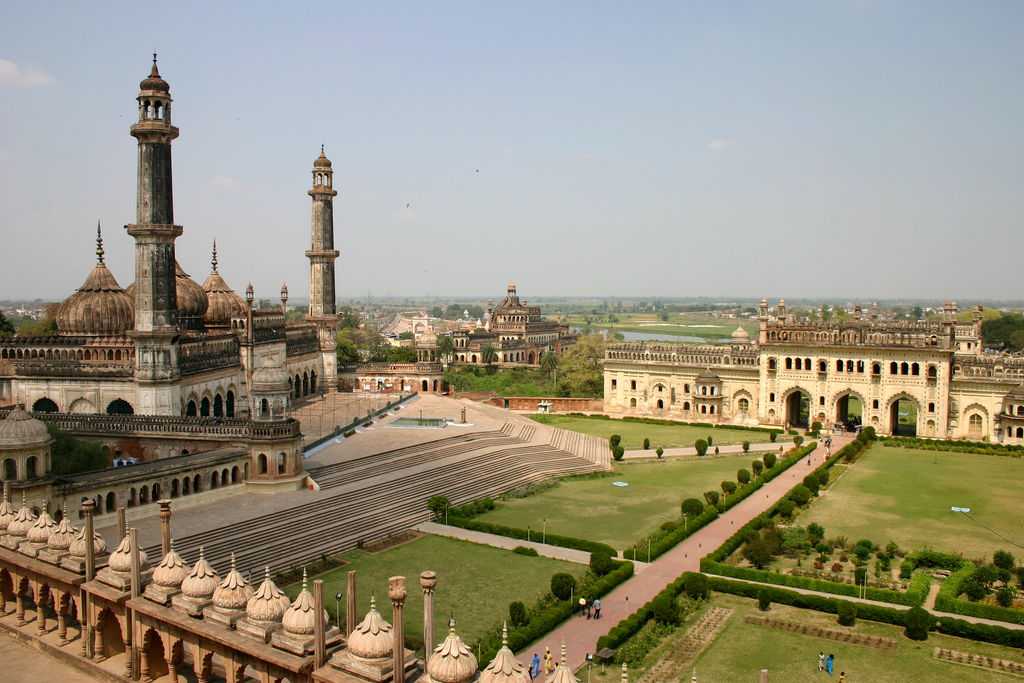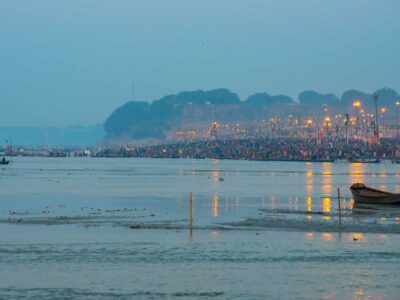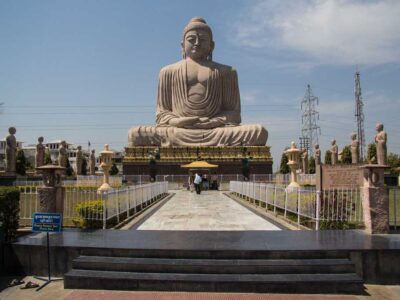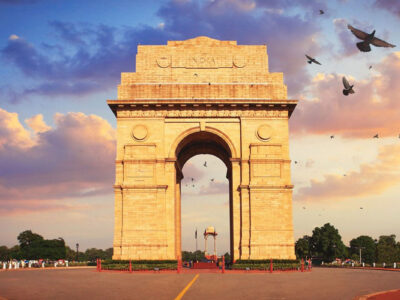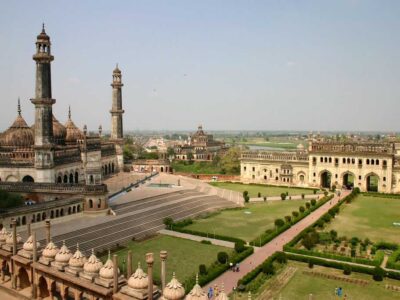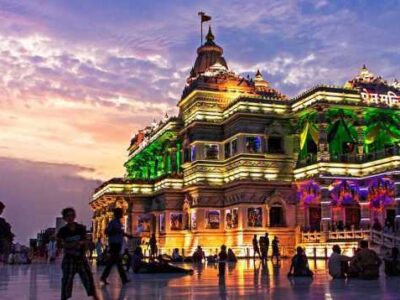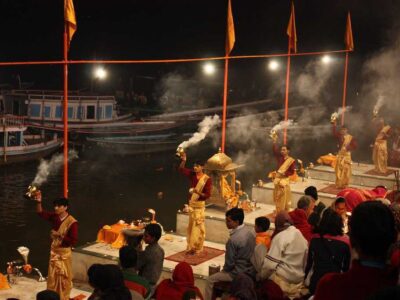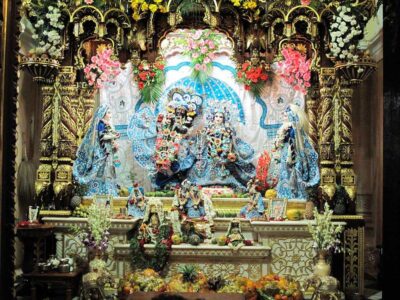Spiritual North India
Uncover India’s ancient spirituality on this nine days trip to its most holy sites, gaining a unique insight into the country’s beautiful blend of belief systems, and perhaps yourself. India is home to the oldest religion Hinduism and has also seen new philosophies taking birth and taken to different parts of the world.
Activities
Uncover India’s ancient spirituality on this nine days trip to its most holy sites, gaining a unique insight into the country’s beautiful blend of belief systems, and perhaps yourself. India is home to the oldest religion Hinduism and has also seen new philosophies taking birth and taken to different parts of the world. India is the originating country for Hinduism, Buddhism, Jainism and Sikhism. Besides, it is also known for a lot Sufi Saints who have spread their teachings across the world. This experience is an attempt to understand and experience a slice of India, its legends, stories and a glimpse of Hinduism, Sikhism, Sufism and Buddhism.
Day 01: Arrive Delhi, You are meet & greet with our company representative and he will escort you to the hotel and will help you with the check -In formalities. Day at your own leisure. Over Night stay at hotel with Dinner.
Delhi - Delhi, an energetic city, with a unique blend of the ancient and the modern era. Delhi has divided into two parts New Delhi, the city created by the British in 1911 as the Imperial capital of India and Old Delhi considered as the Muslim capital of India between the 17th and the 19th century. Delhi is the unique blend of tradition & modernity. It is an architectural college of parks & flyovers, historical buildings and skyscrapers. People live here in different cultures, languages, states, traditions and countries in complete harmony.
After a relaxing breakfast, the tour guide will pick you up from the hotel and take you for a guided sightseeing of Old and New Delhi.
Full day a guided tour of Old Delhi, the 17th century walled city of Shah Jahanabad, visiting the great Jama Masjid, the principal mosque of Old Delhi. Built in the year 1656 AD by the Mughal Emperor Shah Jahan, it is the largest & best known mosque in India. Later take a rickshaw ride through Chandni Chowk, the old marketplace of Shah Jahanabad now a picturesque bazaar.

In New Delhi, visit Raj Ghat, memorial to the Father of the Nation, Mahatma Gandhi. It is a simple black marble platform that marks the spot of his cremation on 31 January 1948.
We will stop for lunch at Good local Restaurant. Afterwards visit Humayun Tomb, This tomb, built in 1570, is of particular cultural significance as it was the first garden-tomb on the Indian subcontinent. It inspired several major architectural innovations, culminating in the construction of the Taj Mahal.
Further we drive past India Gate, memorial built in the year 1931 to commemorate the Indian soldiers who died in the World War I & the Afghan Wars. The names of the soldiers who died in these wars are inscribed on the walls. President's House, the official residence of the President of India, built in the year 1931. Until 1950 it was known as Viceroy's House & served as the residence of the Governor-General of British India.
Culminate the day at Qutub Minar, built in the year 1206 by Qutub-ud-din Aibek. It is the tallest (72m) brick minaret in the world, an important example of Indo-Islamic Architecture.
Overnight at hotel with Dinner.
Day 02: Delhi – Vrindavan - Mathura – Delhi (By coach 3 hrs drive / 150 kms one way)
After a relaxing breakfast, the tour guide will pick you up from the hotel and take you for a guided tour of Vrindavan - Vrindavan, a destination that is more than just being any other geographic location, has stolen the hearts of many. With an essence of spirituality encircling this holy town, Vrindavan is one of its kind. Dozens of temples, constructed in all shapes and sizes, can be seen covering the floors.

Vrindavan is said to be a major part of Lord Krishna’s childhood. It was here that Lord Krishna and Goddess Radha’s love story bloomed, and all the stories of the notorious side of the Lord with Gopis were based on. Here we visit awesome Banke Bihari Teemple, Isckon Temple & Nidhi Van. ( Have Lunch in a Good Local restaurant Pay direct) Later we proceed for Mathura - Mathura is known as Lord Krishna’s birthplace and has many historical and religious sites. One of the most famous tourist places to visit in Mathura is Shri Krishna Janmabhumi, as this location is claimed to be the exact place where Lord Krishna was born, and the jail where he was born is now on view for visitors to see. Besides the jail, the Shri Krishna Janmabhumi (birth palace) also has a magnificent temple.
Drive back to Delhi, Overnight stay at hotel.
Day 03: Delhi – Varanasi (By Flight AI 406 departs at 10:15 hours / arrives at 11:35 hours)
Upon arrival you are meet & greet by our company representative later you are transferred to your pre-booked hotel.

Varanasi or Banaras, mentioned in the scriptures as Kashi, is less of a city and more of a dreamy experience. It is a paragon of Indian culture, philosophy, traditions and spiritual ethos since times immemorial. It is among the Sapta Puries, meaning seven sacred cities of Ancient India. The city is located on the bank of River Ganga which has two tributaries in the city: Varuna and Assi; hence the name Varanasi. The combination of Kashi – the holy city, Ganga- the sacred river and Shiva- the supreme God, makes Varanasi an immortal destination. Today, Varanasi remains the hub of cultural and holy activities. In the field of learning, especially of Religion, Philosophy, Yoga, Ayurveda, Astrology, Dance and Music, the city is certainly unparalleled. The Banarasi Silk Sarees and Brocades are known worldwide for its elegance. Varanasi is full of surprises abounding every corner; the more one explores it, the more one falls in love with it !!
Later afternoon take rickshaw ride to the Old City where you can have a bit of time to stroll the wonderful stimulating area in the Old City around the Ganges. You can walk the narrow cobbled alleyways browsing bazaars and people watch as locals prepare for the evening Aarti. Just before sunset, we will board a country boat to witness Aarti (fire) ceremony performed by a Hindu priest on the banks of River Ganges.
Overnight stay at hotel.
Day 04: Varanasi

Early morning pick up for a very moving sunrise boat ride on the River Ganges to witness the religious ceremonies of Hindus. Afterwards, a walking tour of temples and ghats.
Return to the hotel for breakfast and some time to rest from the early wake-up call, if you desire.
In the late morning (depart at approx 11 am), to visit Benaras Hindu University, regarded as the largest residential universities in Asia.
Bharat Kala Bhavan, located inside the BHU campus, is an art and architecture museum and houses a vast collection of paintings, Hindu and Buddhist sculptures and other materials of archeological importance. The Bharat Kala Bhavan was established in the year 1920 A.D. Bharat Kala Bhavan also has a great collection of miniature paintings from the courts of Mughals and other Kingdoms and principalities. Some of the important sections in the Bharat Kala Bhavan are Mahamana Malaviya gallery, Nicholas Roerich gallery, Chhavi (Painting Gallery), sculpture gallery, Nidhi (Treasures) gallery, sculpture gallery, archaeological gallery, decorative art gallery and Banaras through ages gallery.
Return to your hotel for lunch and refresh.
This afternoon, visit Sarnath where, in 500 BC, Lord Buddha preached his first sermon 'Maha- Dharma-Chakra Pravartan Sutta' (in Buddhist terminology, ‘turn the wheel of the law’) after his enlightenment. The very spot is marked by the Dhamekh Stupa, adorned with delicate floral carvings. You can walk the path, located in the midst of the archeological park, to see the ruins of the small brick monastery where Buddha lived during his visits. About 600 meters before the Archeological Museum, you will see the Chaukhandi Stupa. The excellent Archeological Museum contains an extremely rich collection of Buddhist sculptures of numerous Buddha and Bodhisatva images.
After visiting the museum, continue to Mahabodhi Society’s Mulgandha Kuti Vihar Temple. A major place of worship for the Buddhist community of the world, it was constructed by Bodhisatva Anagarika Dharmapala (1864-1933) from Sri Lanka at the very site where Shakyamuni Buddha preached his first sermon. The temple contains excellent frescoes painted by Japanese artist Kosetsu Notsu. He single handedly completed these paintings in a four year span (1932-36). It also houses a life size statue of Buddha in its sanctum and Gautam Buddha's holy relics are kept on display in the shrine. The monarchy of Japan has gifted a large bronze bell that dominates the entrance of the Vihar. The temple was opened to public on Nov. 11th, 1931 and the Mahabodhi Society of India oversees its affairs.
A Bodhi tree stands on the left (east) side of the temple that is believed to have grown out of a sapling of the one under which Buddha attained enlightenment at Bodhgaya. Under this tree statues of Buddha and his disciples have been displayed. The casket of the sacred relics is taken out in a great procession from Mulgandha Kuti Vihar and goes around this tiny city of Sarnath annually on the anniversary day of Mulgandha Kuti Vihar, which falls on Kartik Purnima (Full moon day) in the month of Nov.
At approx 6pm, local Buddhists chant the words to Buddha's first sermon.
Day 05: Varanasi – Lucknow (By Coach 5 hrs drive / 310 kms)
After breakfast leave by surface to Lucknow check In to hotel. Lucknow - Fondly called the City of Nawabs, Lucknow has established its unique place with its tehzeeb (manners), grand architecture, beautiful gardens, delectable cuisine, and much more.

later proceed for city tour of Lucknow covering Bara Imambara, Chhota Imambara, Rumi Darwaza, Hussainabad picture gallery, Clock Tower, Jama Masjid, Lucknow Residency.
Overnight stay at hotel.
Day 06: Lucknow - Pryagraj (By Coach 4 hrs drive / 200 kms)
After breakfast leave by surface to Pryagraj – It is a focal point of three rivers Yamuna, Ganga and Saraswati (mythological) and is revered to be one of the holiest palces in India for Hindus. A visit here and a dip on the point of confluence is said to rid you of the karmic cycle of birth and rebirth along with flushing away your sins.

Later visit Hanuman Temple, lalita Devi Shaktipeeth, Shree Akhileshwar Temple and Khusro bagh.
Overnight stay at hotel.
Day 07: Pryagraj – Bodhgaya (By Coach 7 hrs drive / 365 kms)
After early breakfast drive to Bodhgaya, Upon arrival check In to your pre-booked hotel.
Bodhgaya Stationed on the banks of the river Neranjana (also referred to as Falgu) in the Indian state of Bihar, Bodh Gaya is the most venerated place for Buddhists throughout the world. A trip to this place offers a unique opportunity to gain valuable insights into Buddhist culture and their way of living.

Evening city tour of Bodhgaya visiting Mahabodhi Temple, Bodhi Tree, Great Budhha Status and other monasteries..
Overnight stay at hotel.
Day 08: Bodhgaya
After breakfast excursion to Gaya - Nomenclature of Gaya is based on the myth of demon Gayasur who Lord Vishnu had killed in a dual. The place is so sacred for Hindus that even Lord Ram had performed Pindadanam here for his ancestors. Legend says that Lord Ram had come to Gaya to pay homage to his ancestors and Sita had accompanied him on his way. Visit Vishnupad Temple & Mangla Gauri Temple.
Afterwards drive to Rajgir, Rajgir literally means "House of the King". Rajgir pilgrimage is a very important Buddhist site since Lord Buddha spent 12 years over here and also preached two sermons. Here we visit- Vishwa Shanti Stupa, Pandu Pokhar, Griddhakuta Peak & Hiuen Tsang Memorial Hall. After wards we drive back to Bodhgaya.
Overnight stay at hotel
Day 09: Bodhgaya – Delhi (By Flight 6E 2416 ETD 14:55 hrs / ETA 16:45 hrs)
After breakfast, late morning you are transfer to Bodhgaya airport to board flight for New Delhi. Upon arrival you are board flight for onward journey.

